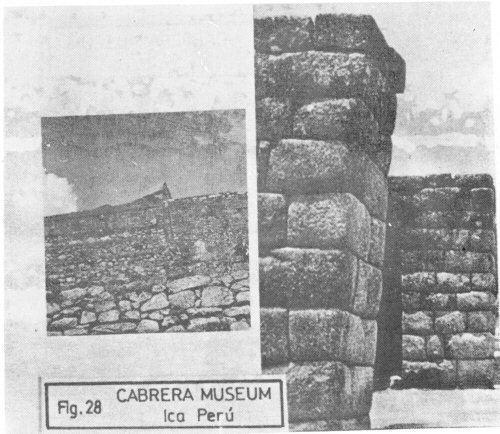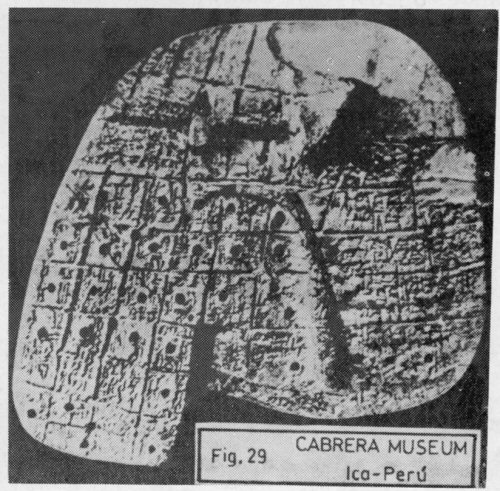(this material is an excerpt from the book
"The Message of the Stones", by Dr. Javier Cabrera)
(EXCERPT #3B)
GLIPTOLITHIC MESTIZAJE
That. some
ancient objects made of gold, ceramic, carved
wood, and cloth have been found in zones inhabited by
different Pre-Incaic cultures and later by the Incas might suggest, as
traditional archeological teaching holds, that
the
objects were made by these cultures and that as a result
they are no more than 3,000 years old. But within the objects attributed
to these cultures, there are distinctions to
be drawn. Specimens differ in the quality of execution and in the
subjects of the designs. It is well-known that the Incas and Pre-Incas lacked
scientific and technological sophistication. This is indisputable. It is
therefore quite impossible, given their
modest technological achievements, that they could even have conceived of
some of the things the objects deal with. There are ceramics from Nazca, for
example, that treat, symbolically, the techniques for space flight. There are
cloths from Paracas whose designs reveal deep understanding of human
microphysical biology. There are objects of
gold and champi - the tumis - that deal symbolically with aspects of
human pathology. These objects, like the textiles and the wood carvings, are of
excellent execution, in accordance with a technology far in advance of that
possessed by the Incas or Pre-Incas. Alongside these objects are other
which are very different in their primitive
execution: objects of gold shaped by hammering or by simple bonding of
one piece to another; ceramics of thick clay, with defective
firing and rudimentary coloration; textiles of primitive weave dyed with
tints with little durability; wooden objects
carved coarsely. Some of these unsophisticated objects have designs with
clear decorative purposes and others mix indiscriminately decorative figures
with symbols that show deep scientific
understanding. This strange juxtaposition of the crude and the
sophisticated is also to be found in figures on the same objects, as well as
from object to object. Curiously, within the same Inca or Pre-Inca grave one is
likely to find ceramics, gold objects,
textiles, carved wood, etc. Whose symbolic features reveal considerable
scientific knowledge or an advanced technological development, next to other
things that suggest that the occupant of the
grave lived a very primitive life: kernels of corn, squashes, wooden utensils,
obsidian spear points, shell or bone necklaces, and crude
needles made of thorns.
How
to explain this unusual juxtaposition? Obviously
the objects that give evidence of scientific
and technological sophistication could not have been created by primitive
men. Instead, these are the messages left by gliptolithic
man, which were originally deposited in very different places from the
places where they ended up. It is logical to
suppose that the Incas and Pre-Incas discovered
sane of these deposits and removed the
objects, thinking, because they were incomprehensible, that they were
made by the gods. The fact that they are today found in Inca and Pre-Inca tombs
reinforces the likelihood that they were considered sacred objects. Where
sophisticated symbols and primitive designs are found in the sane object, we can
infer that the Inca or Pre-Inca men were imitating what they thought to be
sacred , and incorporating familiar elements
from their own lives, in order to establish
a link between themselves and the gods.
Naturally, in these graves there are many objects that have nothing to do
with gliptolithic humanity, that were
conceived and executed entirely by the Incas or Pre-Incas.
Thus, not including the kernels of corn, wooden utensils, etc., there are three
types of objects to be found in Inca or
Pre-Inca graves. First, the objects of superior construction with figures
and symbols that reveal that they were made
by gliptolithic humanity; second, those of crude execution and design
which were clearly the work of the Incas or Pre-Incas; and third, those objects,
also of crude execution, with gliptolithic symbols mixed in with Inca or
Pre-Inca designs. This latter category represents
a sort of cultural "mestizaje" or mixture of the gliptolithic
and the Inca or Pre-Inca.
Besides the evidence found in the tombs, the huge stone
architectonic groupings scattered about Peru furnish further proof of this
cultural mestizaje. The technology employed to create these structures is still
a mystery: how such heavy stones could have been moved to such high elevations;
how they were cut so perfectly that they fit together with no space in between;
how they were held together with no binding material. These feats could not have
been achieved using the technology possessed by the Incas and Pre-Incas.
Archeologists believe that some of thee structures were trade by these cultures
using the labor
of
many, many men over a very long period of time. But
this explanation is unacceptable, because
these structures reveal beyond doubt the use of an advanced technology that
could not have been duplicated by manpower or time. They could only have
been made by men who possessed the appropriate
technology: the gliptolithic humanity. In these same stone constructions
one can see, as evidence of cultural mestizaje, elements of Inca and Pre-Inca
influence: the addition of new blocks of stone, deffectively cut and matched,
placed on top ef or next to the earlier work.
This can be seen, to use only one example of the many that exist in
Peru, in the monument of Machu Picchu (Fig.
28).

FIGURE 28: The impressive stone
structures of Machu Picchu, Cusco, showing defectively cut and joined
blocks - made by Pre-Inca and Inca cultures - placed on top of or beside blocks
made by gliptolithic men,
who built Machu Picchu. This is evidence of cultural mestizaje of the Inca and
Pre-Inca with the gliptolithic.
Outside of Peru there is other evidence of this cultural
mestizaje of the typically gliptolithic with elements of the ancient classical
cultures. Such is the case with the models of livers made of clay that have been
discovered in the regions once under the cultural influence of
the Sumerians. Archeologists have suggested
that these models are related to the practice of adivination performed by
the Sumerians via inspection of the livers of animals sacrificed to the gods;
the favorite liver was that of a sheep. One of these models is divided into
forty small squares, the majority of which have a hole in them; each one of the
squares contains the typical cuneiform writing of the Sumerians (Fig.
29).
Archeologists tell us that this model was probably used by priests for
consultation and for teaching adivination to their students; the small
holes were used to hold a sort of toothpick
which recorded on the model the changes in the liver of the sacrificed
animal. Nevertheless, the widely-held but mistaken notion
that the older the culture the more primitive it must have been
has not permitted archeologists to see in the model what is obvious at a glance
to anyone who does not share this assumption. That is, that this is a schematic
model of the human liver, represented on two
levels: a macroscopic
and a microscopic level. The macroscopic level shows
the shape of the liver with its right and left lobes, its
biliar vesicule and supporting ligaments. The microscopic
level reproduces schematically the hepatacites - the squares in the model - that
is, the cells that comprise the hepatic system, and it also reproduces in
cross-section the biliary capillaries - each
hole that appears in the model - capillaries which have microscopic
dimensions and form a network between the cells. In a few cases the biliary
capillaries are depicted inside the cell (the squares); this is meant to show that bile is made by the hepatic
cells. What we have, then, is a clay object that reveals a profound knowledge of
the anatomy and physiology of the human liver, knowledge that our own scientists
and doctors have only quite recently
acquired. It is certainly not a knowledge possessed by the Sumerians, but it was
possessed by gliptolithic humanity.

FIGURE 29: Schematic model of the
human liver made of clay by the Sumerians, on display at the British Museum in
London. The representation of the hepatic cells (the squares) and the
cross-sections of the biliary capillaries (the holes)
shows that the model was based on a microscopic study of the liver, which
implies a profound knowledge of the physiology
of this organ. Neither the means to observe such microscopic phenomena, nor the
knowledge implied, could have been
possessed by the Sumerians, who added some cuneiform writing to the model. This
model is an altered replica of one of a
series of models of human livers made by gliptolithic man. This altered model is
evidence of cultural mestizaje.
The
scientific information conveyed by the model must have reached the Sumerians or
their ancestors in a form similar to that of the model itself, one of the
objects made by gliptolithic humanity to leave evidence of his
existence and transmit messages to the men
of the future. Not understanding what they saw, the Sunerians reasoned
much as did the Incas and Pre-Incas: they attributed the designs and the object
itself to the authorship of the gods, and
deemed it sacred. So as to ingratiate themselves
with the gods, they made replicas of the object. The addition
of inscriptions and the changing of the placement of some of the holes provide
evidence of cultural mestizaje. The truth of the matter is that the
archeologists are right, to a point: the practice of adivination using a sheep's
liver is ancient, probably originating in the
Middle East and spreading to the Mediterranean region; the
Greeks, Etruscans, and Romans are known to have used it. But what the
archeologists ignore is that this form of
adivination came about because of the discovery of a scientific message
left by an advanced people - gliptolithic humanity - a message that it was
inpossible for the Sumerians to penetrate,
and so was turned to fraudulent uses, just as sometimes modern men alter,
in a strange mixture of admiration and fear, ideas which they do not understand.
This form of adivination practiced by the Sumerians
is in itself a type of cultural mestizaje; indeed, I think that most of the the
beliefs in magic held by ancient peoples
were generated in the same fashion: by the discovery
of
other incomprehensible messages left by gliptolithic
humanity.
BACK TO EXCERPT INDEX